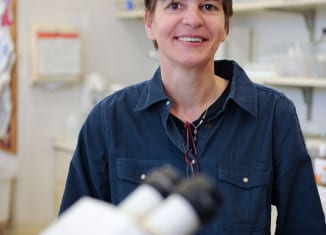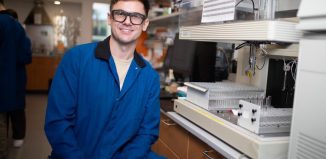CSHL’s Van Aelst studies signals that can lead to disease
Countless forks in the road lead to the creatures that swim, crawl, walk, and fly around the Earth. Some of these moments have a significant effect on the fate of the individual, taking it from the early stages when it’s filled with potential into a bone, a muscle or a brain cell.
In some cases, the process goes off track. The signals, pathways and processes take a different turn, sometimes because of a change in a gene or a protein.
Linda Van Aelst, a professor at Cold Spring Harbor Laboratory, explores how changes in intracellular signaling involving enzymes called small GTPases can lead to disease. She and her team of six graduate students and postdoctoral researchers focus on Ras and Rho GTPases and their regulators, which control cellular growth and the kinds of changes that lead to the shapes of cells, organs or tissues.
Alterations in the genes involved with these enzymes can lead to a range of diseases. “Mutations have been linked to cancer-related processes, including metastasis, as well as to neurodevelopmental and neurological disorders,” Van Aelst said.
Bo Li, an associate professor at CSHL, suggested that Van Aelst, who provides guidance and direction as his mentor, is a leader at the 125-year old research facility.
Van Aelst is “well known for her innovative work on signaling molecules in the cell, including Ras and Rho,” Li said. Her work is “really innovative.”
Van Aelst studies these enzymes by taking what she described as a “bottom up” approach, exploring their development and their role in cellular and developmental processes in the context of the brain. She explores how any perturbation can affect behavior and, once she sees a change, looks for differences in the circuitry development.
Van Aelst looks at the process from the beginning, with the genes, through the protein network. She has sought to understand how some changes lead to metastatic cancer that spreads to a single organ, while others spread generally throughout the body.
Because she is exploring mutations at a basic level, Van Aelst can get involved in a range of diseases and abnormalities, from epilepsy to schizophrenia to mental retardation to cancer.
“Clinicians send me information and want to see if maybe I can use the tools in different mutations in my research” to understand what might be happening with some of their patients, Van Aelst said.
She also gets calls from the parents and family members of patients, who would like to know if a cure is available for a genetic condition linked to something she’s studied.
Van Aelst knows she needs to be “cautious” because she doesn’t want to give false hope at a time when the research may not have pointed the way towards a specific therapy.
With any clinical trials, she has to “make it clear that the findings are not yet mature enough for further development,” she said.
While she’s conducting basic research to understand the process and mechanisms involved, Van Aelst is aware and eager to help an audience desperate for more information and, down the road, a novel treatment.
She does “see the urgency. It’s important that the patients and the family of the patients and the scientists communicate and it is clear what we understand, what can be done, and how far we can do it.”
Van Aelst hasn’t become involved in a therapeutic study yet, but she has reached the point where she knows aberrations in some processes. She hopes to get engaged in the near future in the next step.
“We don’t have something now in hand, but we have several hints” from cellular processes and proteins, she said.
Earlier this year, Van Aelst and her lab published results in the journal Cell Reports in which they found two proteins that provide a critical role in creating the structure of something in the nervous system called a chandelier cell.
Named for the way axonal arbors branch out, these chandelier cells play an important role in affecting neurons nearby. Their size and structure give them the ability to affect the function of other nerves, either turning them on or off, depending on the signal.
Changes in chandelier cell cartridges and/ or function have been reported in disease states such as epilepsy and schizophrenia, she said.
Van Aelst helped provide an important piece of information about these cells by uncovering the important role two proteins play in their structure.
When the function of proteins called DOCK7 and ErbB4 were disrupted, the chandelier cells have fewer branches or boutons. She discovered that DOCK7 triggers the activity of ErbB4.
Van Aelst’s research on chandelier cells “offers insight into how diseases like epilepsy might occur,” Li said.
Now a resident of Oyster Bay, Van Aelst grew up in the Flemish-speaking part of Belgium and was originally interested in archeology and history.
In biology, however, she was intrigued by how “one gene talks to other genes. How does it work? What does it signal? How does it control this or that function?”







